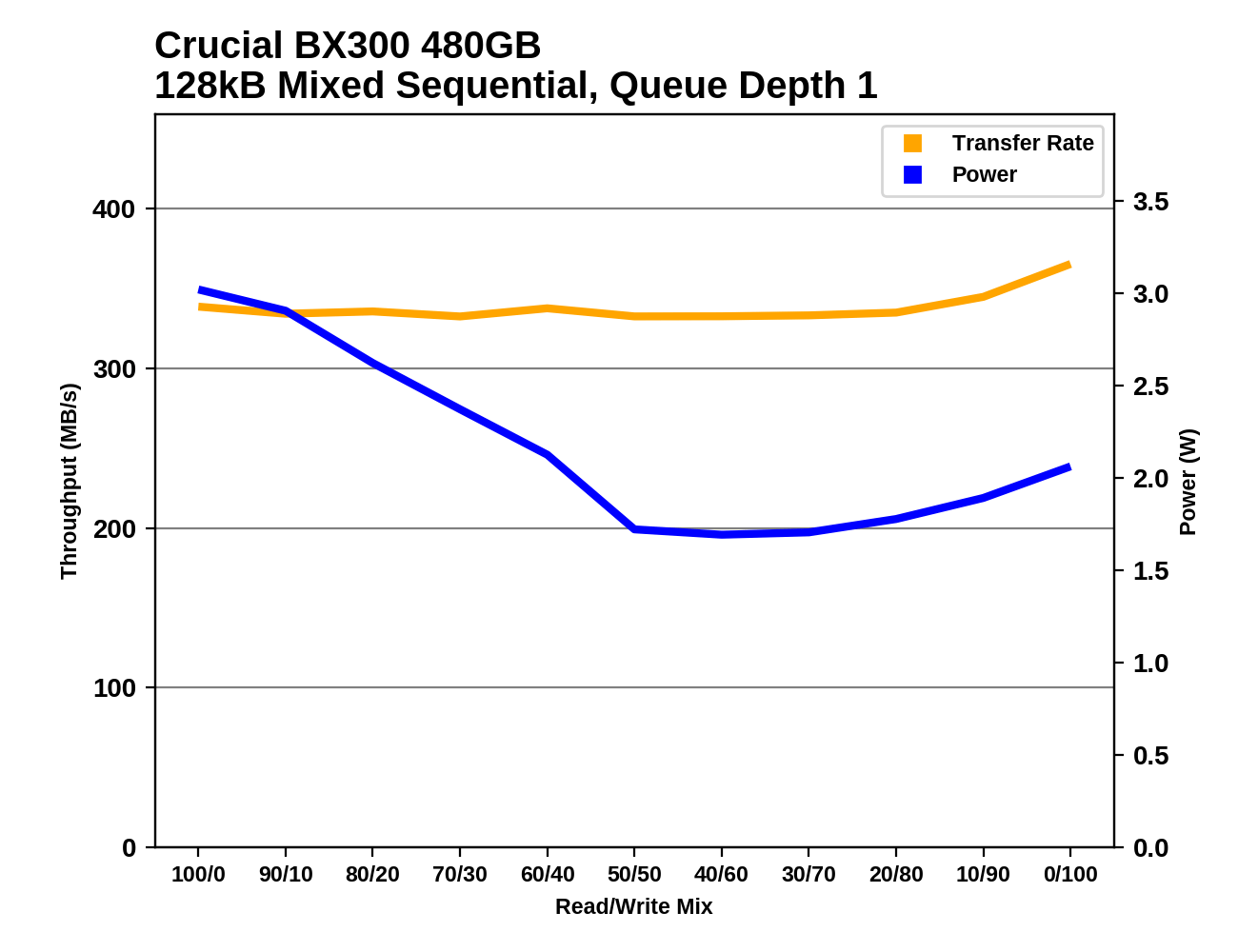The Crucial BX300 (480GB) SSD Review: Back To MLC
by Billy Tallis on August 29, 2017 9:00 AM ESTMixed Random Performance
Our test of mixed random reads and writes covers mixes varying from pure reads to pure writes at 10% increments. Each mix is tested for up to 1 minute or 32GB of data transferred. The test is conducted with a queue depth of 4, and is limited to a 64GB span of the drive. In between each mix, the drive is given idle time of up to one minute so that the overall duty cycle is 50%.

The mixed random I/O performance if the Crucial BX300 puts it in the second tier of SATA SSDs, with Samsung's 850s forming the top tier. The Crucial MX300 is a bit slower than the BX300.

With the exception of the Crucial MX200, all of the drives that outperformed the BX300 are also more efficient. The MX300 is also significantly more efficient despite being slightly slower.
 |
|||||||||
The Crucial BX300's performance on the mixed random I/O test increases slowly as the proportion of writes grows, and it accelerates near the end of the test. The power consumption is flat across almost all of the test, but ticks up as the workload shifts to pure writes.
Samsung's drives are faster than the BX300 across the entire test, while the Intel 545s and Crucial MX200 managed higher average performance scores by performing better on the read-heavy portions of the test and a bit worse during the write-heavy phases.
Mixed Sequential Performance
Our test of mixed sequential reads and writes differs from the mixed random I/O test by performing 128kB sequential accesses rather than 4kB accesses at random locations, and the sequential test is conducted at queue depth 1. The range of mixes tested is the same, and the timing and limits on data transfers are also the same as above.

The Crucial BX300 performs very well on the mixed sequential I/O test, slightly ahead of the Samsung 850 EVO and only 5% slower than the 850 PRO. The MX300 scores closer to the middle of the pack, while the BX200 and MX200 are near the bottom.

The Crucial BX300's power efficiency score isn't quite as close to the top score, but only because Toshiba's OCZ VX500 really stands out from the crowd. The BX300 is ahead of the Samsung 850 PRO and close to the 850 EVO, MX300, and Intel 545s.
 |
|||||||||
The BX300's performance doesn't change much over the course of the mixed sequental test, but it does speed up a bit near the end. Power consumption starts out high but drops dramatically across the first half of the test, and then follows the shape of the performance curve.










90 Comments
View All Comments
Ryan Smith - Tuesday, August 29, 2017 - link
We're still finalizing that for the new testbed.plopke - Tuesday, August 29, 2017 - link
Quiet impressed by the improvements , nice surprise. But why would anyone still get a mx300 <525GB capacity. Am I missing something here? Crucial always confuses me with what they want the MX vs BX to be.Or would they discontinue MX 300 <525GB , now I am curious if they will be making a MX400 still this year.
wallysb01 - Tuesday, August 29, 2017 - link
Why get <525? Because its still $90 or $60 less in total cost and if you don't need >120 or 240 GB, why not save the money. Plenty of use-cases don't need much more than just enough to boot a computer.vladx - Tuesday, August 29, 2017 - link
So MX300 is using TLC NAND while BX300 is now MLC? What the hell is going on with Micron/Crucial's marketing team?MajGenRelativity - Tuesday, August 29, 2017 - link
To be fair to Micron/Crucial, it seems like par for the course for marketing teams to confuse peoplemelgross - Tuesday, August 29, 2017 - link
Most people don’t care. They look at capacity, price, and maybe, performance. How the company gets there isn’t important.Samus - Sunday, September 3, 2017 - link
The ideal solution to market a product is to take a draft description from the designers, engineers, etc, and condense it to a slogan and a product segment that is palatable to the general population.The problem seems to be the inability for marketing departments and advertising companies to adapt ideas and technology without loosing the core functions of those ideas and technology.
As you said, a lot of them just focus on price or "what works" (as in, keeping with the previous naming conventions, even if they never worked in the first place...because changing it now would admit defeat)
Samus - Sunday, September 3, 2017 - link
I've been saying this about AMD and even Intel's marketing teams for years. And who can forget NVidia's GTX 970 memory configuration flop?The fundamental problems seems to be nobody with any engineering mentality is on a marketing team. Which is a shame, because as an engineer, I firmly believe we are good at selling (ourselves and our ideas) to management on a daily basis. And the morons in management think just like the morons in marketing.
msabercr - Tuesday, August 29, 2017 - link
Are we sure this is MLC? It seems an aweful lot like the intel 545s which is TLC.Ian Cutress - Tuesday, August 29, 2017 - link
Yes, we are sure.